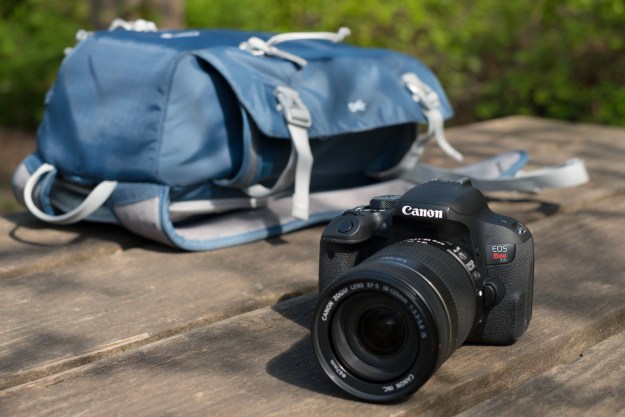While it may not have been as exciting as the Lumix LX100 or the Europe-only CM1 unveilings, the new Lumix DMC-GM5 from Panasonic still deserves a bit of attention. A successor to the GM1, it’s still one of the smallest interchangeable lens cameras around. Despite the smaller size, Panasonic managed to shoehorn an electronic viewfinder (EVF) above the 3-inch touchscreen LCD – a feature not found in the GM1.
To make room for the EVF, the pop-up flash from the previous form-factor has been removed, in favor of a hot shoe; the GM5 comes bundled with an external flash. The EVF is rated at 1,166k dots with 100-percent field of view and 100-percent color reproduction. Video capture has also improved to Full HD at 1080/60p (versus 60i of the GM1), plus cinema quality 24p. Some new function buttons and a dial have been added on the back. The GM5 can now shoot panorama photos, and a new Snap Movie feature lets you shoot Vine-line short videos that can be edited in-camera. It may look the same as the GM1, but the GM5 has enough cosmetic changes to make it a different camera.
Specs wise, however, the GM5 retains the 16-megapixel Live Mos Micro Four Thirds sensor and Venus Engine capable of ISOs of up to 25,500. The contrast autofocus system “excels in both speed and accuracy by exchanging a digital signal between the camera and the lens at max of 240 frames per second,” Panasonic says; we tried an engineering sample and found the AF to be peppy, although we will reserve all judgment for a production model (as the sample clearly had some performance issues with startup and shutdown). The AF has a speed of 0.06 seconds, and autofocus tracking at 5 fps. Like in the new LX100, the GM5 has 22 filter effects in the Creative Control mode, plus features like time-lapse, stop-motion animation, retouching, and manual long-exposure; there’s also focus peaking, a silent operation mode, highlight and shadow control, and level gauge.
Related: Panasonic’s LX100 is a 4K pocket rocket with the heart of a bigger camera
The GM5 will sell for $899, and, because Panasonic is targeting this camera toward step-up users here in the U.S., it will come bundled with a 12-32mm standard zoom kit lens. It’ll come in black or white in the U.S., although other countries will get additional colors.

In addition to the GM5, Panasonic also has also recently announced two Micro Four Thirds Lenses. The Lumix G Vario 35-100mm, with an aperture of f/4-5.6 aperture, is a compact retractable lens with optical image stabilization. Panasonic says it’s ideal for portrait or close-ups with smooth bokeh.
The second lens is a Lumix G 14mm with an f/2.5 aperture. It’s not entirely new, as Panasonic says it’s an existing lens but with a cosmetic design change. This lens, and the 35-100mm, will cost $399 each.
Lastly, Panasonic will release a firmware update for the 4K-capable Lumix GH4 and FZ1000 cameras. Both cameras will receive the 4K Photo mode that was unveiled in the LX100 (allowing you to grab 8-megapixel stills out of a 4K video), as well as performance enhancements for video recording, such as continuous loop recording in the GH4 and 4K MP4 support in both cameras. Panasonic has a tentative release date of October.
Related: Panasonic Lumix GM1 review
Editors' Recommendations
- Smaller and cheaper, the full-frame Lumix S5 is exactly what Panasonic needed
- Canon EOS R5 vs. Sony A7S III vs. Panasonic S1H: Best full-frame for video?
- The best Micro Four Thirds lenses


